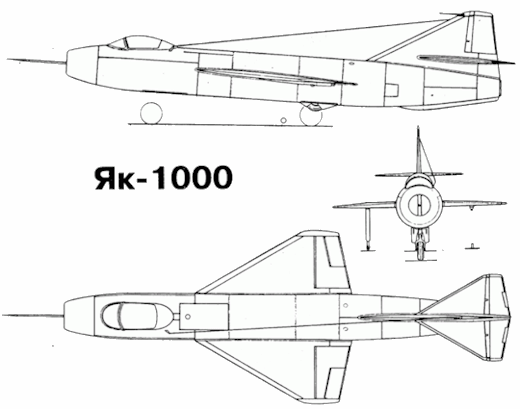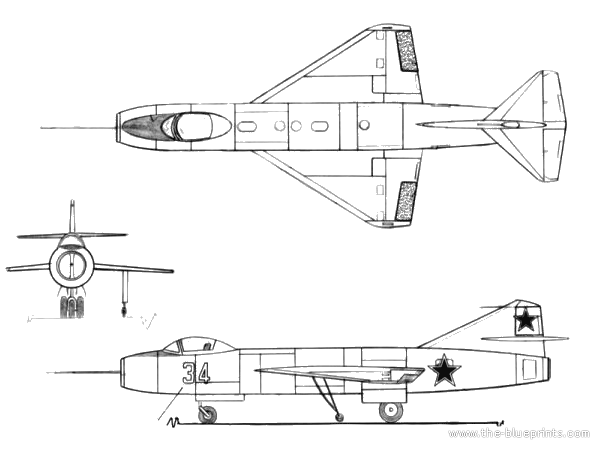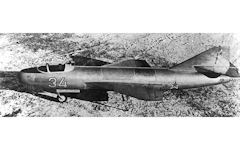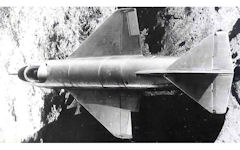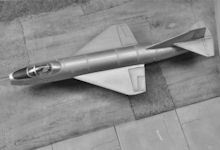Yak-1000
Of the experimental Yak-1000 until now very little was known: established in 1951 and never flew. Meanwhile, it was undoubtedly one of the most unusual aircraft of its time - is one of its kind evoked associations with fantasy and wonder about it that has not yet been told anything. History of experimental aircraft Yak-1000 directly related to prospecting for TsAGI wings for high-speed aircraft, managed to restore the sparse and scattered documents preserved from those times, as well as the memories of direct participants in the events.
In the second half of 1945 TsAGI began extensive research on the new wing jet aircraft. Soon, in the framework of the Institute formed two teams to compete with each other in the direction of this field of activity. The first consisted in completing swept wings. It was headed by the then young scientist, now a well-known academician Vladimir Struminsky. Second, an alternative direction was to create a low aspect ratio wings. These wings are received in TsAGI +rombovidnyh- generic name, although their shape in terms of significantly different from rhombus and was close to the triangle. The complex of the wings thus performed under the guidance of scientist aerodynamics PP Krasilytsikova.
At first, the practical use of swept wings received undisputed priority. However, as the fighter flight approached speed to the speed of sound, wings of small aspect ratio became more and more attractive for scientists and engineers. Their basic aerodynamic advantage was less drag in transonic and supersonic speeds than the swept wings. The best were the characteristics of longitudinal stability in the transition through the speed of sound and at high angles of attack, the wing design gets tougher and almost twice as easy. According to estimates of the time, when the weight of the fighter design of equal squares bearing surface with a diamond-shaped wing obtained by 7-10% less than the swept. However, for all its virtues, wings of small aspect ratio caused many serious problems. In particular, it was difficult to provide acceptable load-bearing characteristics during takeoff and landing modes, complicated by issues of lateral stability and handling. Nevertheless, proponents of low aspect ratio wings believed these problems solvable and continued to work.
By the end of the 1940s aerodynamicists at TsAGI managed to create the wings of small aspect ratio suitable for practical use. With the work in this direction in the first place were acquainted fighter designers, because at the time these wings were good only for this class of aircraft. The greatest interest in the implementation of new ideas was expressed by Yakovlev, though his design office was very wary of aerodynamic innovations in the arrangement of jet fighters. In this case Yakovlev, apparently convinced by adherents of the new wing, and more that behind them stood the authority of TsAGI, significantly raised in the turning point in the history of aviation technology. And Yakovlev decided to try the new idea.
According to the scheme proposed by TsAGI, Yakovlev's design bureau planned to build a new supersonic fighter turbojet TR-5 (AI-5) construction of AM Lyulka. Estimated maximum speed fighter was unprecedented for its time value and corresponded to about M = 1.7. Realizing that unresolved and unclear problems are too much to just go to the creation of a combat vehicle, Yakovlev, in agreement with the TsAGI in October 1950, was ordered to design and build a small experimental plane with the engine RD-500 (licensed reproduction English +Dervent- V-). The aircraft was named Yak-1000 and represented a kind of future fighter layout.
The fuselage was semi-monocoque all-metal stressed skin with, was a body of revolution with a maximum diameter of only 1.2 m fuselage duralumin frame, formed by the 30th frames, three power beams and a set of stringers.. In the rear part of the air brakes were. The fuselage housed two kerosene tank: 430 liters capacity front and rear 167 liters.
Bicycle landing gear was retractable, with oil-air cushioning, consisted of a main, front and two underwing racks. Main wheels and front struts - two-chamber brake with high pressure lnevmatikami size of 570x140 mm. The front wheel was manageable. Wheel of the main rack in the retracted position does not entirely fit into the fuselage, and it protrudes from the contours of the closed fairing. Issue and chassis cleaning, flaps, air brakes and control wheel brake is pneumatic system.
The pilot was in a hermetically sealed cabin, equipped with ejector seat. The canopy provided a very good overview of the entire upper hemisphere.
The Yak-1000 was intended for the in-flight aerodynamic configuration and testing of landing modes. Yak-1000 was designed and built extremely quickly. By the end of February 1951 the aircraft was in flight test stations company at the airfield FRI in Zhukovsky. By that time, in a large wind tunnel TsAGI T-101 came to a close study of full-scale aircraft layout. TsAGI studied mainly the aerodynamic properties of the takeoff and landing modes. At the same time they tested aircraft models in supersonic wind tunnels.
Experts estimated the maximum speed of the Yak-1000 level flight at a height should be 1,100 km / h, which corresponds to approximately the speed of sound. For this engine, as the RD-500 is a surprisingly high figure. For comparison: the speed of light Orthoptera Yak-23 (1947) with the same RD-500 was nearly 200 km / h less. This speed boost was conditioned by a fundamentally different aerodynamic configuration Yak-1000.
In addition to the aerodynamics, the Yak-1000 had several features makes it stand out. One original element was the aircraft control system. While all high-speed fighters already hydrodynamic boosters, the Yak-1000 did not have them at all. The operating handle supplied with electric mechanism to control the gear ratio from the handle to the ailerons and rudders height. This mechanism was operated either automatically upon reaching a certain speed, or manually by the pilot's request.
The bicycle type chassis, which became a hallmark of Yak fighters, started with the Yak-50 (1949). In view of the bad bearing properties of low aspect ratio wing required a powerful mechanization of its trailing edge. Flaps occupied almost the entire scale. Free space for the ailerons and was not placed on their rear end portions of the flaps.
March 3, 1951 began ground tests Yak-1000. Test pilot DV Zyuzin noted that the plane taxiing low speeds could quickly gain speed. But soon it was in trouble. When the plane took off with flaps, even in low crosswind when reaching a speed of 150 km / h it began to expand due to the considerable forces occurring in one of the under-wing landing gear that gave while unfurling a big moment. The effectiveness of the ailerons at this speed was still not enough to fend off the roll moment and reduce the pressure on underwing rack, and rolled out the plane from the runway. Efforts on the counter were such that underwing wheel did not withstand even a high-speed taxiing. In the run-up to the flaps retracted similar situation arose at a speed of 250 km / h. With such a shortcoing there could be no question about test flights. In addition, experts had serious concerns that while landing to slide (crosswind) at the moment it touched the ground or under heavy braking, the aircraft could tip back.
After the first runs of the Yak-1000, which brought so many problems, the designers developed a number of activities to finalize the airplane. In particular, it was planned to set the wheels in place of underwing suspension, put in the nose of the aircraft 100 kg of cargo to the run-up to the front wheel. It was also proposed to amend the structure of wings and the tail section of the fuselage. Ending in March 1951, full-size mock tests Yak-1000 in wind tunnel T-101 revealed that the take-off and landing speeds will be significantly higher than initially expected. This required further refinement and chassis to the limit exacerbated the already difficult problem of taking off and landing.
Difficulties encountered in the creation of the Yak-1000 did not arise only with takeoff and landing. There were very poor damping properties of the wing. In addition, the aircraft had a very unfavorable ratio of the moments of inertia about the transverse and longitudinal axes, which would have greatly hindered piloting. The ratio of these moments of inertia - a very important parameter, largely determined the handling characteristics of the aircraft. For fighters in the 1940s this ratio fluctuated within rather narrow limits: from 2.2 to 3.6. But for the Yak-1000, its value was 16 (!), Which was five times greater than that of the MiG-15 and a third more than the well-known Soviet supersonic fighters late 1950s such as the MiG-21 and Su-9, which had control systems which already had a special device to improve the stability.
Taken together, this could lead to a buildup of in-flight aircraft in roll, and even loss of control. Thus, around the Yak-1000 there was a set of intractable new problems, and the initial enthusiasm of the creators of the aircraft began to gradually give way to skepticism. Doubt was not so much about the Yak-1000, as the very idea of the aircraft of such a scheme. It was becoming increasingly clear - this aerodynamic configuration was not suitable for a fighter. However, work on the Yak-1000 continued for some time yet. In June 1951, KB TsAGI presented its recommendations to improve the aircraft. To get rid of unmanageable reversals in the run-up and run, experts from the institute offered instead of one main wheel landing gear strut to put two and gauge at least 0.5-0.6 m (use conventional chassis on the final design was not possible). In addition, set out proposals to improve the sustainability and reduction efforts on the control stick and the pilot were given recommendations on what flight modes should be used in the first flight as safe.
Having received the proposals TsAGI, Yakovlev took the difficult decision to abandon finishing the aircraft. The risk of flight tests proved unnecessarily large, and in the light of experience to date the prospect of creating a full-fledged fighter based on the Yak-1000 is seemed unreal. One of the leading TsAGI specialists in the field of mechanics and flight dynamics, recalling the epic associated with Yak-1000, considered the decision by Yakovlev as only true and suggested that even if the plane and took off, then, by virtue of their characteristics, most likely it would have crashed in the first flight.
In some respects, the Yak-1000 ahead of his time. It is only then there were special devices (so-called oscillation dampers), whose inclusion in the control system provides security even piloting such aircraft as the Yak-1000. And then, in the early 50's, science was not yet able to solve all the related problems with this machine. It would seem that the idea of the adherents of rhomboid low aspect ratio wings had failed.
But in life, everything turned out differently. Firstly, such wings have been used for some types of missiles. Second, the failure of a Yak-1000 was for scientists TsAGI impetus for further searches, rethinking and revision of some established ideas in matters of layout supersonic fighters and the choice of the main parameters that had a great influence on the further progress of Soviet aviation. And finally, the third group aerodynamics TsAGI, headed by PP Krasilytsikovym expanded research front has moved from the wing to the extension +rombovidnyh- only 1.5 triangular with high elongation (approximately 2) and worked for two years the aerodynamics of the wing. The triangular wings are widely used in the Soviet Air Force. Suffice it to recall aircraft such as the MiG-21 and Su-9. But this undoubted success was preceded by and not taking off the Yak-1000, the real role of which in the history of Soviet aviation was much greater than that of many planes fly and what may seem at first glance.
| Modification | Yak-1000 |
| Wingspan, m | 4.59 |
| Length m | 11.69 |
| Height, m | 4.26 |
| Wing area, m2 | 14.00 |
| Weight, kg | |
| empty aircraft | 1860 |
| normal takeoff | 2470 |
| engine's type | 1 RD-500 turbojet |
| Thrust, kgf | 1 x 1590 |
| Maximum speed km / h | 1100 |
| Practical range, km | 600 |
| Practical ceiling, m | 12100 |
| Crew | 1 |
| Armament | two 20-mm guns |
|
NEWSLETTER
|
| Join the GlobalSecurity.org mailing list |
|
|
|


